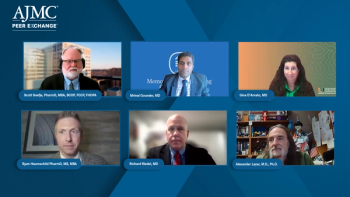
Wounds: Managed Care Organizations and Coordinated Care
A comprehensive review of the role of managed care organizations and coordinated care in the treatment of wounds.
Transcript
Peter L. Salgo, MD: Does a payer prefer a patient to be seen at a wound care center, or an ER [emergency department], or a DPO [designated provider organization], or some sort of outpatient setting? Where is the sweet spot today for a payer?
Michael T. Kazamias, MS, DPM: I would say there isn’t any. Do you know of a sweet spot?
Robert J. Snyder, DPM, MSc, CWSP, FFPM RCPS: No. Again, my “depends” answer is again coming up.
Peter L. Salgo, MD: You’ve got to rubber-stamp that.
Robert J. Snyder, DPM, MSc, CWSP, FFPM RCPS: It really depends on the payer. It depends on the gatekeeper. If the gatekeeper is capitated and understands the dynamics and the importance of this, and knows that if the patient is seen by the right clinician at a wound care center, then the cost will actually be less than it would be if the patient didn’t go to that center. That patient will likely be referred there. Others may not be as well versed in this topic. They’ll flatly refuse things like hyperbaric oxygen, as an example, because they “don’t believe in it,” as if it’s a religion.
Michael T. Kazamias, MS, DPM: Here’s an area in which the product manufacturers can bring some very interesting technologies to bear in order to leverage the capabilities of what we would call the centers of excellence—like an outpatient wound care center—into the community, where the home health agency can have technologically enhanced capabilities in order to access a center of excellence’s protocols for wound management. And the attendant costs go down.
Robert J. Snyder, DPM, MSc, CWSP, FFPM RCPS: One other thing to add, and that’s the continuum of care. I think what tends to happen is, particularly if a patient is hospitalized with a serious problem—let’s say an infection or even sepsis and then is discharged—very often they fall into a black hole somewhere. They’re not really seen by a specialist.
Peter L. Salgo, MD: I fixed their sepsis—come on!
Robert J. Snyder, DPM, MSc, CWSP, FFPM RCPS: That’s a big problem.
Michael T. Kazamias, MS, DPM: Well, it’s a good point. A lot of times, many stage IV patients who are the costliest comparatively and from an acute perspective, by definition can’t get to an outpatient wound care center with enough reliability to be able to establish an appropriate treatment protocol.
Peter L. Salgo, MD: Their pseudomonas went away.
Michael T. Kazamias, MS, DPM: Exactly.
Peter L. Salgo, MD: It’s gone. We fixed it.
Michael T. Kazamias, MS, DPM: But the hole didn’t.
Peter L. Salgo, MD: But the hole through which it entered remains.
Michael T. Kazamias, MS, DPM: Correct.
Robert J. Snyder, DPM, MSc, CWSP, FFPM RCPS: Right. We don’t treat just the hole; we treat the whole patient.
Peter L. Salgo, MD: If there is a managed care approach to this in which a managed care organization standardized care, first of all, I can’t believe I’m speaking well of this, because most doctors beat managed care organizations over the head. Does that make sense to you that this managed care organization is going to mandate that a patient, who had a hole and had a sepsis, gets the hole fixed or tended to as well? Does that make sense?
Samuel D. Young, MD, MBA, CPE, CHCQM: It certainly makes sense. Whether or not it would happen, from what I know about how most managed care organizations think and function, I’m not sure. However, It certainly makes sense.
Peter L. Salgo, MD: By the way, I’d like to point out. You did say the managed care organizations do think.
Michael T. Kazamias, MS, DPM: To that point, maybe they haven’t looked at it correctly because of the conditions that can beset Medicare beneficiaries. We talked earlier about how a chronic wound is up in the top 5 for cost-ratio reimbursement. In other words, they get a higher bump in their risk adjustment. It’s 1 of the only conditions that can be healed in a reasonable period of time. In other words, let’s say an HCC [hierarchical coexisting condition] is in the area of ventilator dependency, which is really close to where a chronic wound is. Think about that: ventilator dependency, according to Medicare, costs about as much as a chronic wound.
Peter L. Salgo, MD: That’s huge.
Michael T. Kazamias, MS, DPM: Can you heal or can you otherwise—what is the percentage of patients who can be healed on ventilator dependency versus those who can be healed appropriately through standardization of treatment protocol and all the other advantages we can consolidate? All the tools are there. And if they’re consolidated, and you heal a wound in a 90-day period of time, there’s an incentive for that managed care company to be able to cut that cost. It’s 1 of the few areas that can quantifiably be cut.
Robert J. Snyder, DPM, MSc, CWSP, FFPM RCPS: The second part of that equation is to prevent the rate of recidivism as well. Once those wounds heal, if the patient is not compliant—or concordant, as we like to call it now—or their disease…
Peter L. Salgo, MD: Is that really the PC [politically correct] phrase for compliant? Concordant?
Robert J. Snyder, DPM, MSc, CWSP, FFPM RCPS: Yes.
Peter L. Salgo, MD: OK, I just wanted to ask.
Michael T. Kazamias, MS, DPM: It’s an interesting point, because I base my entire career on this. One of the sobering things that I heard from a medical director was—we always try to close the wound, close the wound, close the wound. So I was on the phone with 1 of the managed care medical directors, and I said, “You know, doc, I wasn’t able to completely bring this wound to closure.” And he said, “Mike, since you’ve been treating this patient according to the model that I had set up, this patient has not been readmitted to the hospital in an entire year. I don’t care if you ever heal that patient.” That patient has been stabilized, they haven’t had an infection, their quality of life has improved, and they haven’t been serially readmitted to the hospital. That is a positive outcome. That patient may never heal.
Robert J. Snyder, DPM, MSc, CWSP, FFPM RCPS: For them.
Michael T. Kazamias, MS, DPM: The patient may never heal. We’ve seen those for whom they closed it 90%. However, if we as physicians can keep them in a stabilized state—and that wound does not present itself with other life-threatening comorbidities—I would think from a quality-of-life perspective, if the patient is doing better, the entire system does better.
Robert J. Snyder, DPM, MSc, CWSP, FFPM RCPS: Having a realistic expectation of whether that will occur, those individuals who really understand wound management as a profession can kind of gauge whether this wound has the likelihood of healing and whether we can stabilize.
Peter L. Salgo, MD: There is a subtext to your story, which is you to say paid attention to the wound. That is it say, regardless of whether that wound closed, that patient got seen on a regular basis and got attended to, and the wound got cleaned and infected material got removed, coordinated care.
Michael T. Kazamias, MS, DPM: It was treated like a chronic condition. There were case managers at the health plans who were looking at what we were doing. We gave them access to electronic medical records, so everyone on the treatment team could see what’s happening with that patient. If an order came in for a low-air-loss mattress or some other modality, there wouldn’t be a delay, an artificial delay in treating that patient.
Robert J. Snyder, DPM, MSc, CWSP, FFPM RCPS: So that continuum of care versus what we commonly refer to as siloed care, where individuals are coming in, doing what they do, no communication, they’re leaving and so be it, and call me when you need me again. Which normally will be the case.
Peter L. Salgo, MD: Thank you for the opportunity to assist in the care.
Robert J. Snyder, DPM, MSc, CWSP, FFPM RCPS: That’s correct. The continuum of care is extraordinarily important.
Peter L. Salgo, MD: Avoid hypoxia and hypotension is usually in that note too, right?
Robert J. Snyder, DPM, MSc, CWSP, FFPM RCPS: That’s correct.
Samuel D. Young, MD, MBA, CPE, CHCQM: The major hang-up in this coordination of care is the transmission of the right trigger, which are the claims data. Unfortunately, managed care has the same issue that Medicare does in recognizing what’s driving the healthcare cost. If the claim doesn’t come through primarily as a wound or a wound-related issue, that coordination of care may never be triggered at the health plan level.
Michael T. Kazamias, MS, DPM: It might not be triggered. That’s a very good point that you bring up. What we did was we were assisting the health plans in their data mining by looking at inferences, similarly in the way they capture MRA [magnetic resonance angiogram]. We’re looking at inferences as to what would the most probable inciting diagnosis be for this admission. Then they start getting better granularity on the costs. Some of the health plans we worked with found out that their PMPM [cost per member per month] for wound management, when the totality was taken into account—from home health, to podiatry networks, to surgical networks, to outpatient wound care centers—when that was added up, the PMPM approached cardiology.
Newsletter
Stay ahead of policy, cost, and value—subscribe to AJMC for expert insights at the intersection of clinical care and health economics.






































